Yesterday was "Dia de muertos" (Day of the Dead), and I figured, it's been a while since I've made a monster post of something so much interesting, so without any, any ado, I'll jump into what might be the most interesting post you've seen and read in November (haha yeah, totally intended).
All the pictures were taken in the Mexican city of Puebla, which is why I pinned it on @pinmapple right there.
I decided to go Shrine Offering hunting, which is something huge in Mexico during these dates, and gladly I found tons of them for you to delight with.
Myth, Legend, and the fusion of two worlds
(the earthly world and the underworld in case that wasn't clear.)
2021 marks the 500 year anniversary of Tenochtitlan's fall - that's the Aztec or Mexica civilization main city - and it also marks the bicentennial anniversary of the Mexican Independence from Spain.
In Mexico, the indigenous cultures conceived death as a dialectic unity: The whole of a two part entity of life and death, which made death be part of every inch of their culture. Death is present everywhere and represented by one figure, and this made it easy for their traditions to survive the pass of time and allowed it to become internationally recognized and even granted the Unesco title of World Heritage.
The origins of the Day of the Dead tradition backs from before the Spanish came to America. The Spaniards had a unitary soul conception, which didn't allow them to understand how the indigenous perceived death, and how individual entities had a different wish when they parted from this world.
For prehispanic civilizations, the act of dying was only the beginning of the journey to Mictlan (the underworld), the realm of the dead. This journey lasted 4 days. Once they arrived in Mictlan, the deceased traveler offered several gifts to the lords of Mictlan, whom will send him to one of nine regions of the underworld, where the deceased would spend a trial period of four years before continuing his journey and finally reaching the final step, where he would rest until the end of times, called the Obsidian of the dead.
The prehispanic burials consisted of the body accompanied by two types of objects: Those that the deceased enjoyed in life, and those that the deceased might need in his journey through the Mictlan. The Shrine offering is the representation of these burial traditions, and reflect the cosmovision the prehispanic civilizations had about death.
The Shrine offering is a fundamental element in the Day of the Dead celebration. It is believed that the deceased return to this earthly realm on this day to spend it with their loved ones, and also to comfort them for their loss.
And so, as the most important Mexican tradition during this time of the year, I decided to share with you many, many (yeah, many) examples of Shrine offerings to the Dead.
To begin with, I found some shrines in specific parts of the city I live at the moment, so let's begin with those and after that, if you are still scrolling, I'll show you some random ones that I found in bizarre places like main squares, homes, public gardens and whatnot.
Municipal Palace

From the time the city was founded in 1531, this was the space where "the authorities convened for whatever was required". The original construction went through various modifications and in 1897 a new project was entrusted to British architect Charles T. S. Hall, who designed it in the English Elizabethan style, this work was concluded in 1906.

The elegant double arcade patio, the majestic Carrara marble staircase, the stained glass, windows metaphorically depicting the city and the Council room in grand Renaissance style are some outstanding features.

The two fundamental documents of the history of Puebla - the Royal charter, which gives the city its title, and the Royal Provision, which confers to Puebla its coat of arms - are kept there.
The facade includes the replica of the "Esquilon San Jose", which is the bell that is rung every year on September 15 during the "Grito de Independencia" (Shout of independence) ceremony.
 |  |
|---|
House of the Dolls - Casa de Las Munecas
Famous among the constructions of the 18th century, this house received its name from the human figures made in Talavera tiles that appeared on its facade.
It has a series of balconies that alternate with the panels of 16 Talavera figures, popularly known as "Los Munecos", which, according to tradition and one interpretation, represent the Councilmen who were against the construction of this house, as its owner wanted it to be higher than the houses of the government.
In the 20th century the first cinema theater of Puebla city was installed here, later it served as a hotel, pulque bar, optician and newspaper office. Today it stands out in all its splendor, converted into the University Museum of the Puebla state university, and it has a restaurant of the same name where Puebla's gastronomy can be enjoyed.
Shrine Offering: The death of the Fifth Aztec Sun
The arrival of strange aliens to Measoamerican coasts, beginning in 1517, signified a tragedy for the inhabitants of those lands. These men of white skin, blond hair and high stature, sailing imponent navies, escaped all and every logic from the natives. Something else rang an alarm: they were not precisely friendly.

Soon, these visitors knew that a powerful, magnificent kingdom exists inland. A kingdom feared or hated by everyone they ran into while exploring this new land. A kingdom where gold and riches abounded: The famous Tenochtitlan, governed by a no less known monarch: Moctezuma.

By 1520, the spanish army captained by Hernan Cortes were fully commited in a conquest war against the Mexicas, the proud population from Mexico-Tenochtitlan. Cortes knew how to capitalize the discontent from pretty much everyone towards the Mexicas (Aztecs) and enrolled in his troops many tribes such as the Tlaxcaltecas, Otomis, Totonacas, Chalcas and many other small tribes. Some of them joined the Spanish horde with riches in mind, others just wanted to stop paying tribute to the Aztecs and get rid of their grasp.

Despite the heroic defense of the city lead by Cuauhtemoc, in August 13 1521 the city fell, leading to the capture of Moctezuma. That day there was a rain downpour accompanied with lighting and thunder. That was the day the Fifth Aztec Sun died, and the skies didn't hide their pain.
 |  |
|---|
To those Fallen during the SmallPox pandemic in 1520
This shrine offering is dedicated to the inhabitants of Tenochtitlan that died during the 1520 pandemic, which was a decisive factor to the defeat of the Aztecs against the Spanish invaders, who actually survived the smallpox due to their herd immunity brought from Europe.
The Spanish infected the Tlaxcaltecas, which in turn infected the Aztecs, killing both monarcs and normal people. This disease was called by the indigenous as Totomonaliztli or disease of the blisters. This Pandemic killed at least 150,000 Aztecs from Tenochtitlan and Tlatelolco, out of a total population of 300,000.

This shrine to the dead presents archs made of flowes and corn, representing the 13 skyes in the Mesoamerican conception of the universe. Corn is the symbol of the circle of life and death, which begins with the grains of corn which generate the cob.
In the table there are elements related to the offering to the dead such as fruits, puff pastry which represent the skull of the dead person, and they are the result of the mix of the prehispanic beliefs and the catholic faith.

The dogs are called Xolozcuintles, which is a breed that still exists to this day. Furless dog who accompanied the deceased through their trip across the different levels of the underworld, until they reached the Mictlan.
The rug represents Cuitlahuac, the captain of the Aztec who lead the defense of Tenochtitlan, who died of smallpox. The red balls surrounding the rug represent the smallpox.

In the prehispanic world exists a duality between life and death represented by the devourer & birther goddess Tlaltecutli (with her image under the main arch).
Shrine in The House of Crumbs
The odd name of this bulding is bound to its origins. The tradition says that it was built by Jesuits with the crumbs they collected, a poetic form to refer to the handouts (charity) to the church. The house was run by the Espiritu Santo Jesuit School (holy spirit) and when it became the State College, the house came to be part of the property of this educational institute. In 1825, it operated as the Federal Treasury building. This building was rescued from total abandonment in 2010.

During its restoration process, pieces with great archaeological value were discovered, such as the remains of a grace with over 3,500 years old which is the oldest evidence of human inhabitation in the San Francisco Riverside. For this reason, it was determined that those pieces had to be exhibited in the museum on the second floor, to show the studies about the grave as well as daily objects from the viceregal age.

Shrine to the Dead in the Ancient School of San Pantaleon
Founded in 1726 by the Bishop Domingo Pantaleon, this school offered the subjects of Theology, Law and Solemnities. The face portrays two coats of arms. The name "Justice Palace" is displayed in the center of the main entrance and onver the window is the date of its opening.
This shrine is dedicated to the women who were a major influence in the Independence war of Mexico against the Spanish.
The women portrayed here are Josefa Ortiz de Dominguez, Leona Vicario, Gertrudis Bocanegra and Altagracia Mercado.

Josefa Ortiz was a criolla, a spanish woman born in Mexico, understood perfectly how the treatment from pure blood Spanish towards Mexicans affected society, and how it affected Mexicans. She joined literary groups and intellectual movements and she organized conspiracy meetings in her house, trying to support the independence. She was a key member of the conspiracy of Queretaro.
Leona Vicario was a criolla and daughter of a wealthy merchant who got orphaned at 18. She studied art and science thanks to her wealthy position, which then gave her a critical sense to be a journalist. She joined the independence movement with information and wealth to help the cause. She was jailed several times, once with her husband and another with her daughter.

Shrine Offerings from the Prehispanic Mexico

Brace yourself, because you are about to enter a series of shrines all different from each other and at the same time, portraying the same ideas and concepts, just in diverse forms. All the tribes from prehispanic Mexico had their own way of honoring the dead and distinct forms of offerings.

Nahua Shrine Offering to the Dead
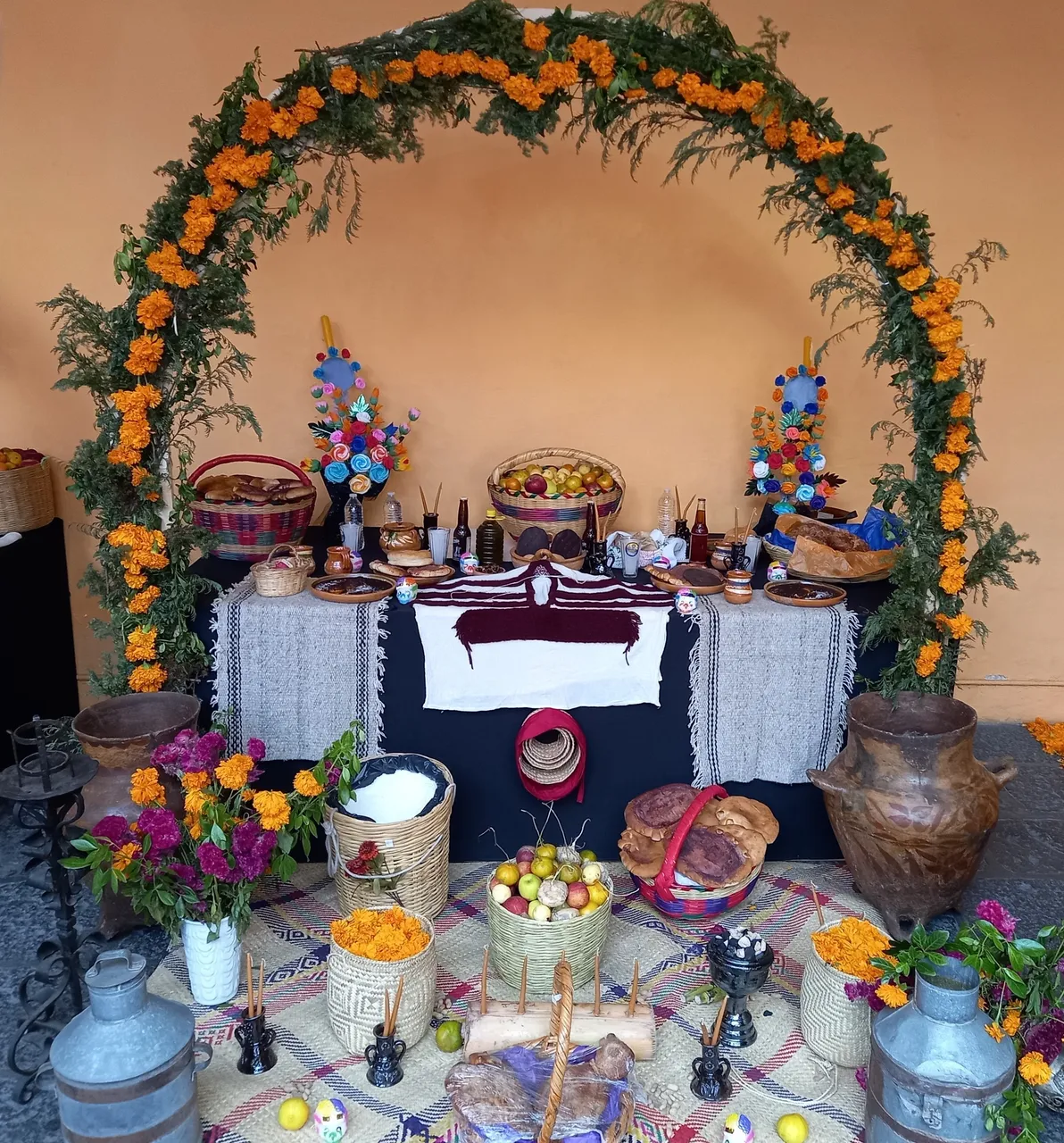
The Nahuas settled in what is today the state of Puebla, mainly in the Tehuacan area. The wax ornaments with flowers in paper and cloth, the regional suits, and the elaboration of the peculiar breads such as the tochi are witness of the cultural and traditional Nahua diversity.

Mixteca Shrine Offering to the Dead
This shrine is highlighted because of the use of craftsmanship in palm, and they share some background with the Popolocas tribes. It is custom to use rugs and curtains everywhere, hanging, in the floor, over the table, which serve so the deceased can use them to rest once he reaches the Mictlan.


Otomi Shrine Offering to the Dead
Using Amate paper, the Otomi tribe is a reference to preserving the traditions of the prehispanic. They represent the gods that grant permission to the deceased to come back and enjoy what is in the shrine. The Amate paper also represent the deities that are linked to nature and to the four cardinal points.

It is also in places like Honey where the shrines strives to represent throughout the breads, flowers, fruits and forms that reminisce the spirit of the person.

Mazateca Shrine Offering to the Dead
The Mazateca traditions are in danger of disappearing, only three little towns in Puebla still preserve the shrine offering tradition: Coyomeapan, San Sebastian Tlacotepec de Porfirio Diaz, and Santiago Miahuatlan.
A table with a brand new tablecloth engraves just for the occasion, dress up a flower and fruit arch that represents the door to the underworld, the Mictlan.

Shrine Offering to Mictlantecutli

Mictlantecutli is the lord of the Underworld in the Mexica or Aztec comsmovision and his reign extended to all those deceased within the Mictlan. He reigns the underworld with his wife Mictecaccihuatl at his side.
In the Borgia Codex he is represented as an antropomorphic being, half skinned colored white with several yellow stains and red spots, which symbolize the body's decomposed nature after one dies. The head corresponds to a skull with no eyes, and yet a strong stare is reflected when one see it directly, full of power and darkness. It is said that his stare possesses the strength and power of the stars above, flowing to his mouth, a mouth so strong that it could eat up every living being and every star in the universe.

Mictlantecutli wears a headdress made up of rosettes and paper cones particular to just this one deity, which are accompanied by circular elements that correspond to his eyes. His earlobes are perforated with bones that hold human handbones. His crisped hair, black as coal wears human eyes as ornament.
This shrine exists in his honor.

Totonaca Shrine Offering to the dead
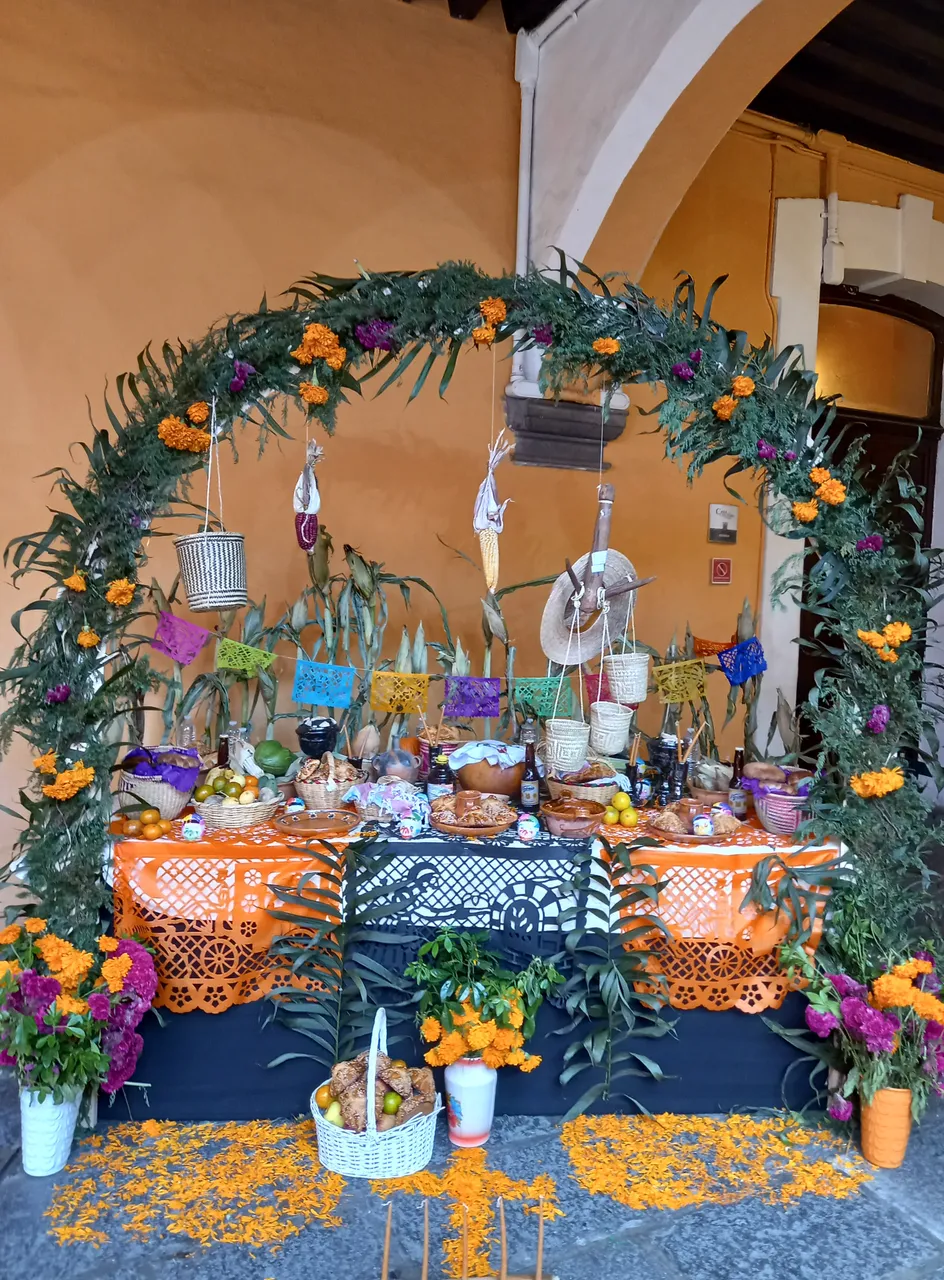
This shrine is characterized by an overall humidity that one can see from the distance, mainly because the region where Totonacas settled was humid as hell, where the corn, fruits and foliage welcome the deceased.
The Totonaca offering is highlighted by the variety of vegetation used to represent the voyage from the terrane world and into the underworld.
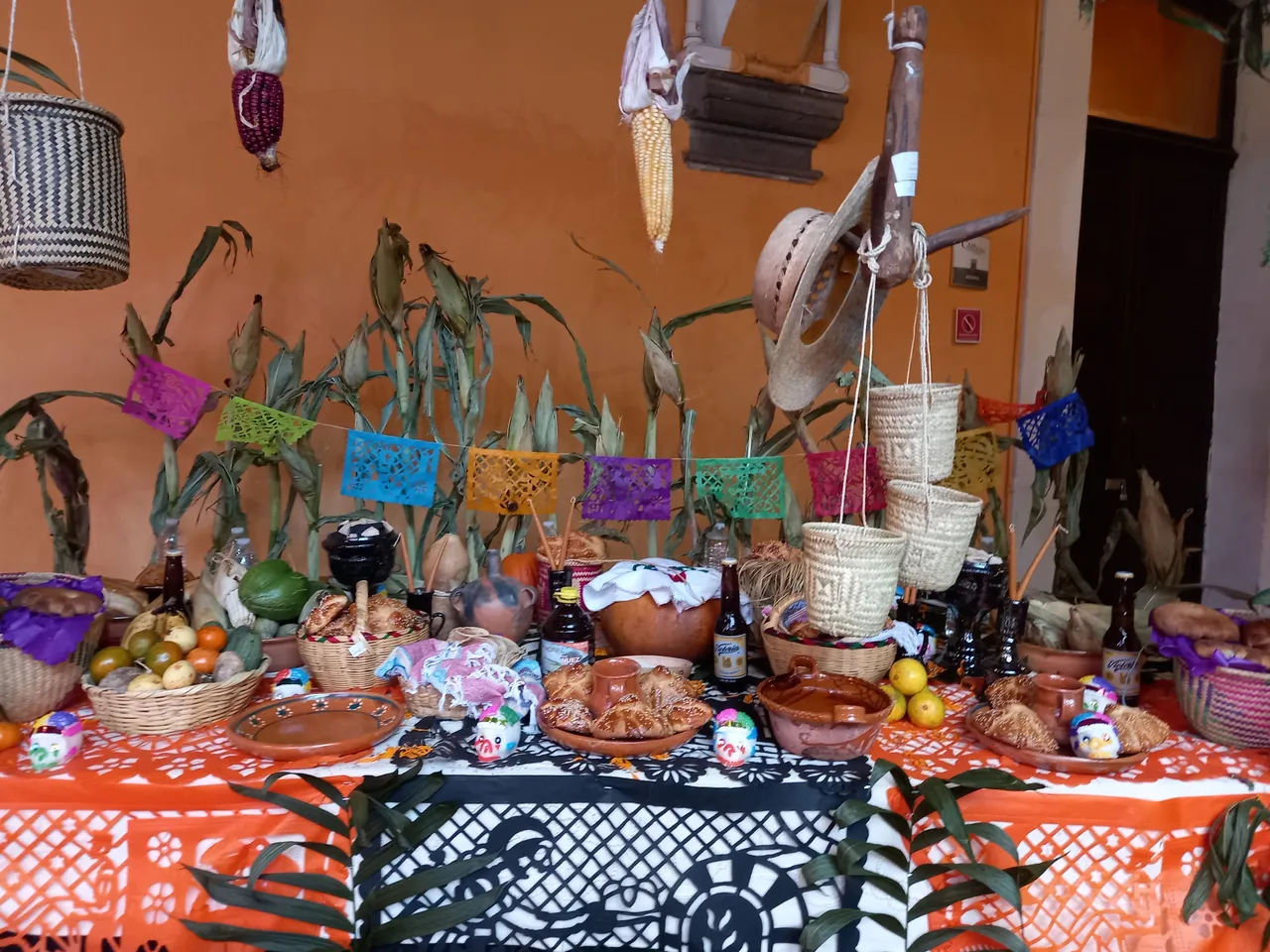
Tepehua Shrine Offering to the dead
With only 237 official speakers nowadays, the Tepehua people preserve the shrine offering tradition in the towns of Pantepec and Francisco Mena. The shrine's layout is mainly based on the central arch. Bread, fruits and liquor are hanged from the arch to facilitate the deceased taking them.

For the shrine the Tepehuas also use banana bunches and with the tree trunks, support the yellow bee wax.

Popolna Shrine Offering to the dead
With just a few towns were the traditions are still honored, San Felipe Otlaltepec, Ixcaquixtla and Santa Ines Ahuatempan, the palm fabric, palmilla, little table sppon, and quiote elements never go unnoticed in their shrines. It is common to find archs full of palm, wicker mats in the floor, tables and headboard, as well as tenates and baskets to put on the food in.

The connection between the artisanal activity and the tradition highlights the importance of the popular art and the cosmovision of the Popolca customs.

Mestizo Shrine Offering to the dead
The mestizo shrine is the result of peak syncretism. Indigenous, prehispanic, and of comercial exchange elements are mixed in this type of shrine to give form to the identity that includes light glass mud, cardboards, sugar skeletons, mache paper, and food product of the popular mexican cuisine.
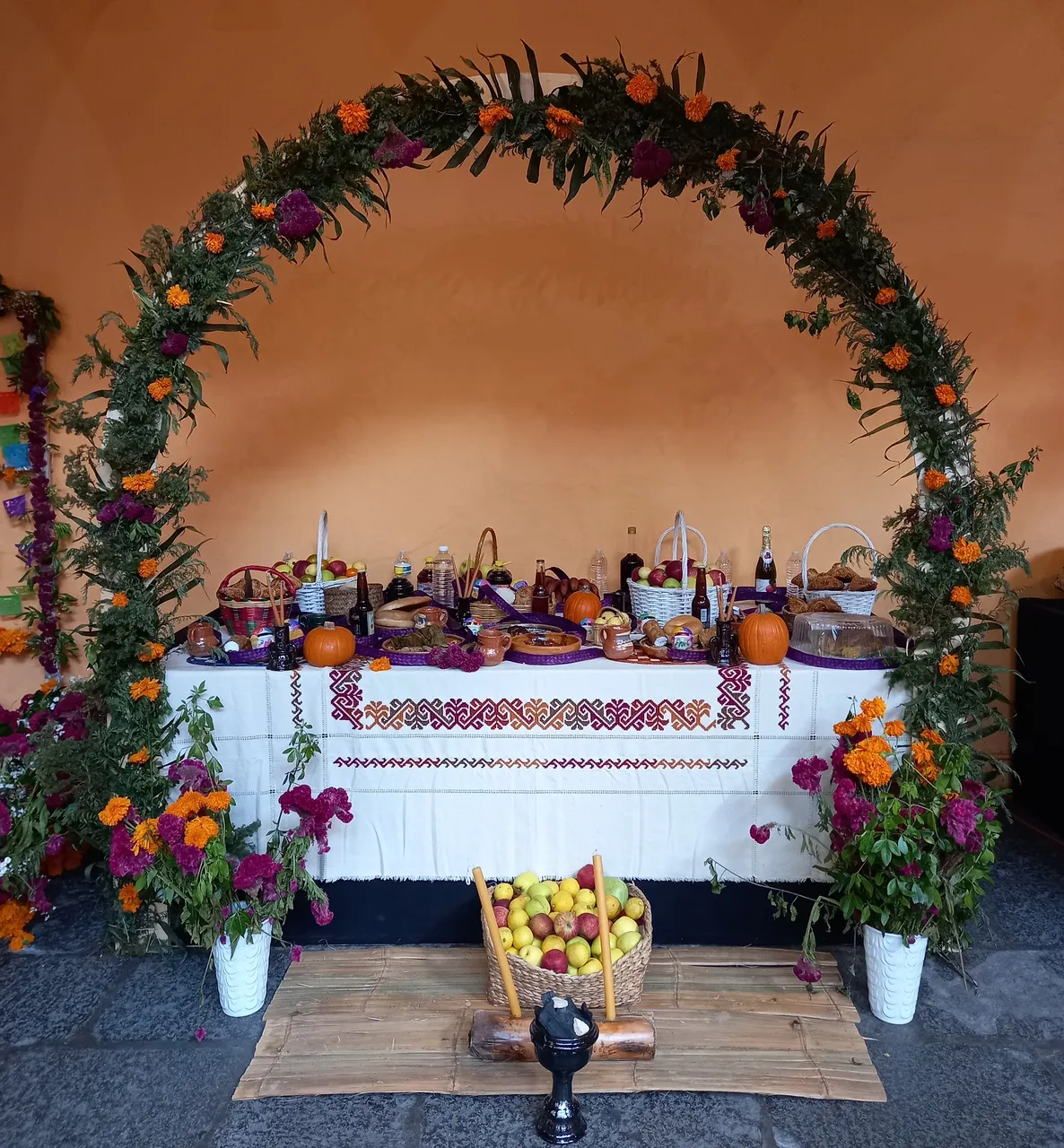
The Mestizo shrine emphasize being placed in major cities and populated areas, where people from many places of the country live at, adding their own traditions to the local ones, mixing others, and adopting practices from several different towns and tribes.

Shrine Offering to the Jaguar
The Jaguar, enigmatic inhabitant of the woods and jungles in Mexico, reminisce the beginning and ending of times, as well as the dark world where he is uncontested lord and master. His multiple and varied prehispanic representations, as well as his presence in parties and mayan folklore, invite us to venture into this sacred universe.
It was commonly thought that Jaguars that crossed through the darkness used to swallow the stars, depriving men from their light. He was the feline that encaranted the powers and forces of darkness, and when this agresivity unchained that devoured the stars, he also did it to the moon and the sun during eclipses. This concept is reflected clearly in the terms used in different ancient indigenous civilizations for the phenomena: In Mayan he's called "bite of the sun".

A little bit of more mixed shrine offerings
If you made it this far, you deserve the random shrine tour with no words to distract you, so when the customer asks, I try to deliver:






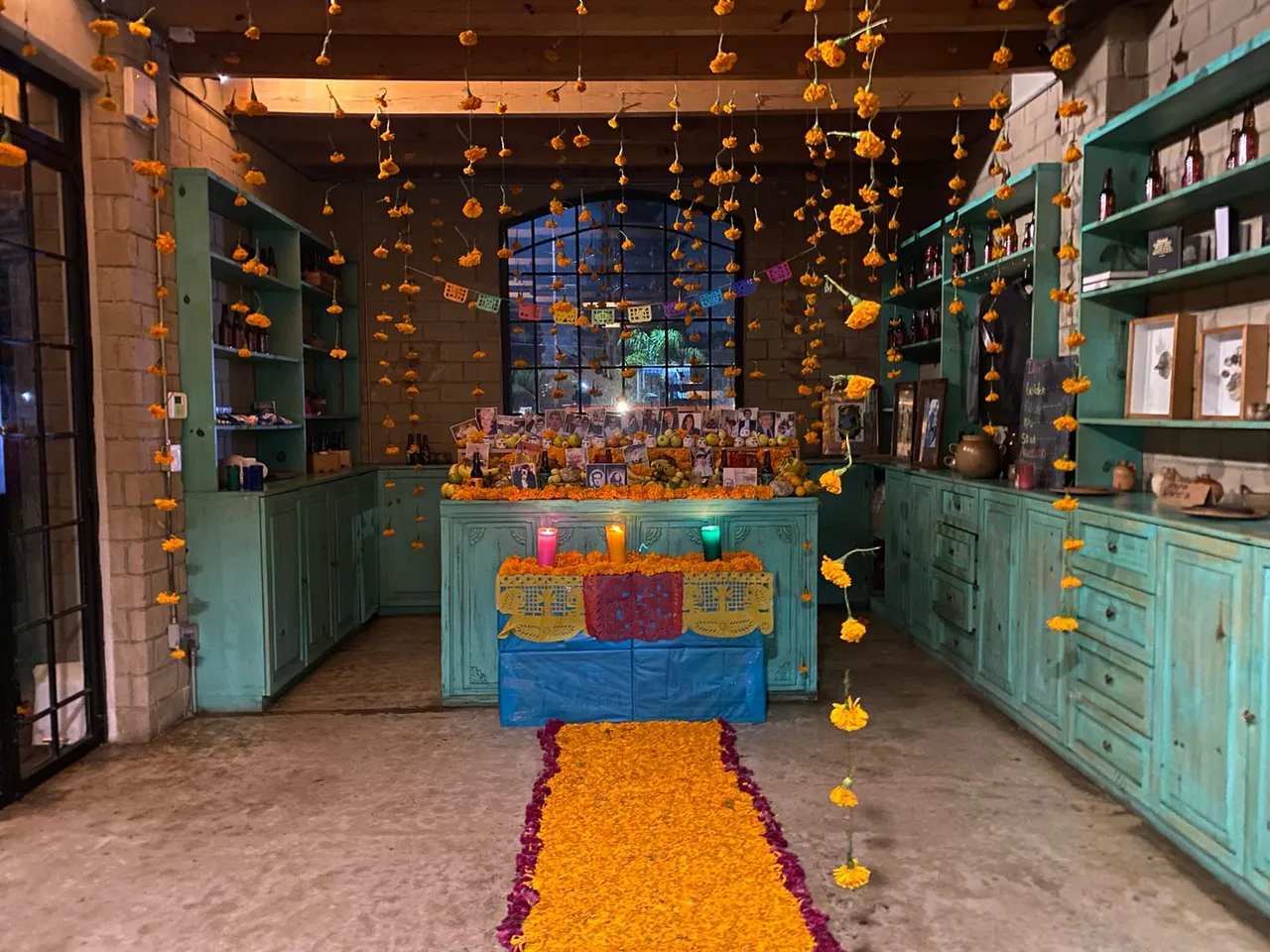

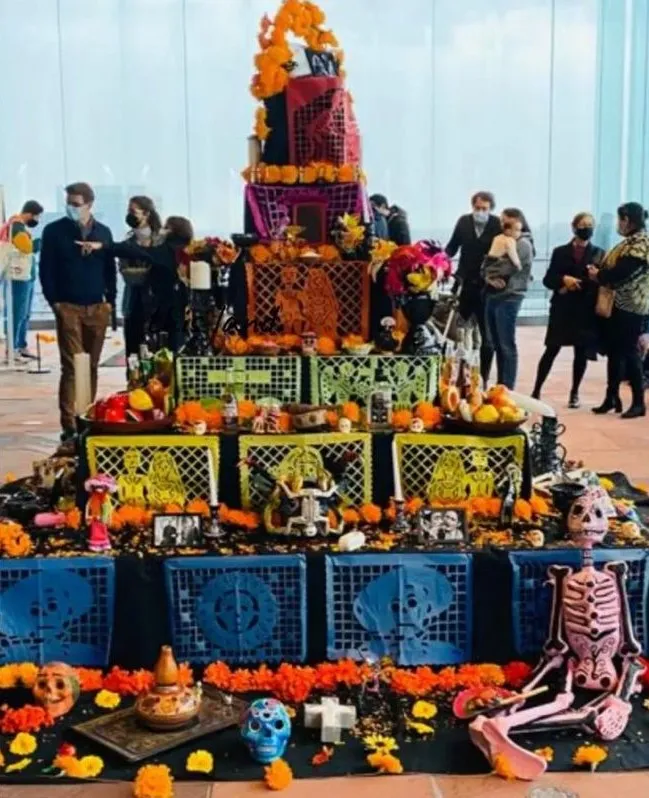


This last one really hits close to home, no matter who you are...

Here rests the young Ivan Mozo Huerta, born in May 2000 and deceased in October 2020. Memory from his parents and grandparents.

This means that this kid was killed right in the corner where I found this little shrine, probably in the hands of crime... but who knows. All we know is that he was taken from this world way too soon.